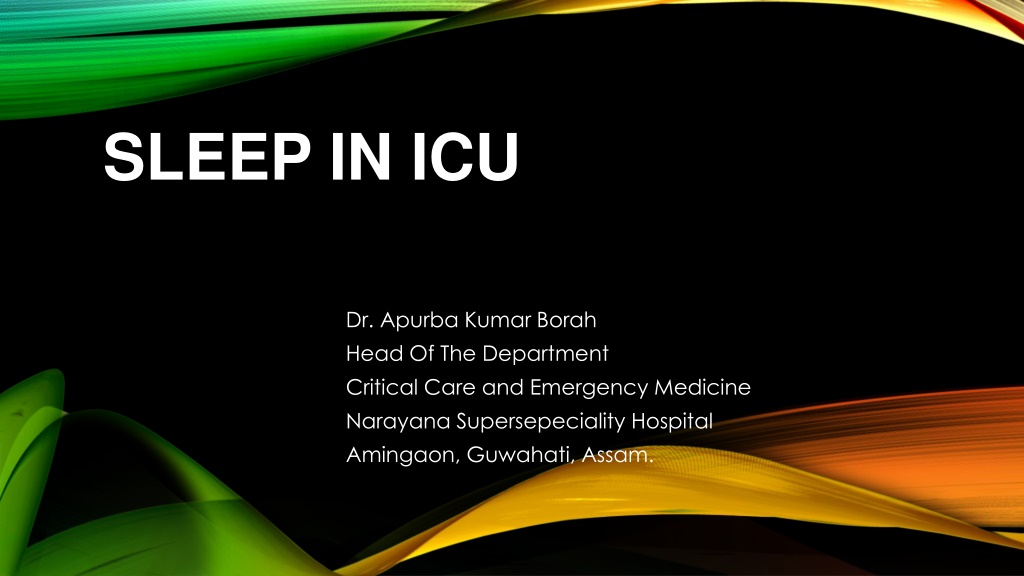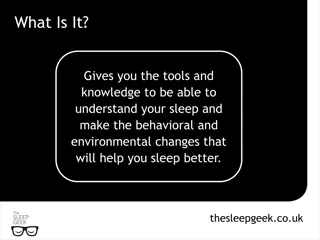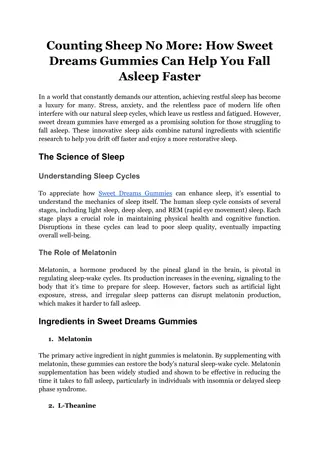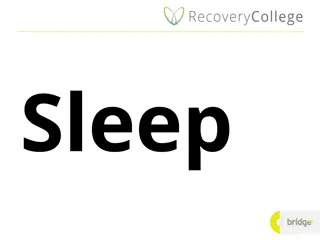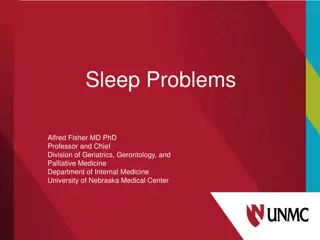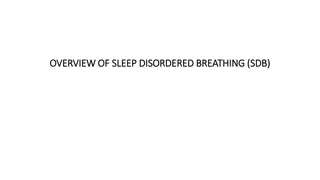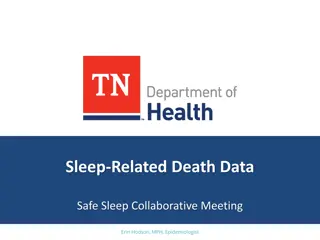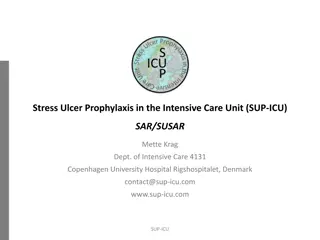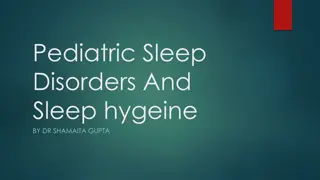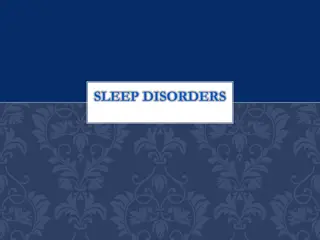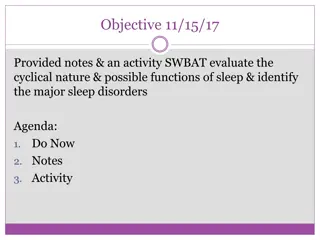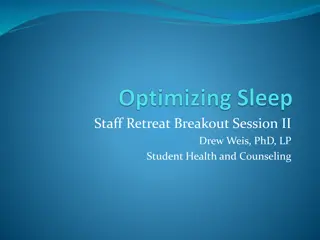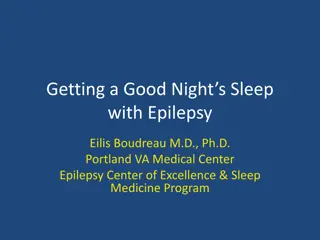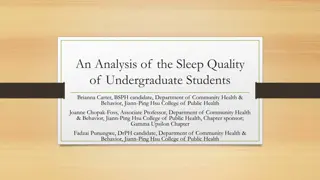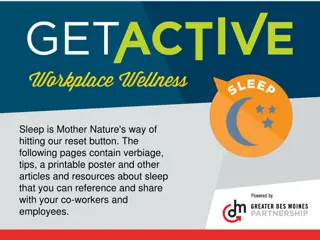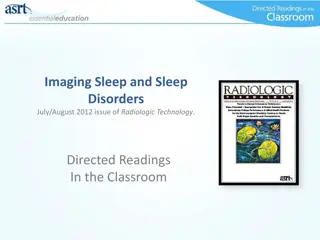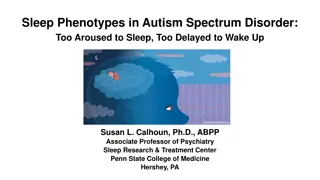Understanding Sleep Patterns and Architecture in the ICU Setting
Sleep in the ICU is crucial for physiological rest and emotional well-being, but it is often disrupted due to various factors. Normal sleep architecture consists of REM and Non-REM sleep cycles, each vital for different restorative processes. Non-REM sleep has three stages, including deep sleep important for memory consolidation. Rapid Eye Movement (REM) sleep involves dreaming and perceptual learning. Understanding these sleep patterns in critically ill patients is essential for optimal care.
Download Presentation

Please find below an Image/Link to download the presentation.
The content on the website is provided AS IS for your information and personal use only. It may not be sold, licensed, or shared on other websites without obtaining consent from the author. Download presentation by click this link. If you encounter any issues during the download, it is possible that the publisher has removed the file from their server.
E N D
Presentation Transcript
SLEEP IN ICU Dr. Apurba Kumar Borah Head Of The Department Critical Care and Emergency Medicine Narayana Supersepeciality Hospital Amingaon, Guwahati, Assam.
OVERVIEW. Sleep is a naturally occurring periodic, reversible state of cognitive and sensory disengagement from the external environment, from which a person can be aroused by sensory stimulation Sleep is essential for physiologic rest and emotional wellbeing Chemically-induced sedation is physiologically different to normal sleep and lacks restorative effects Sleep patterns and architecture in the critically ill is usually abnormal There are multiple causes of disrupted sleep in ICU
NORMAL SLEEP ARCHITECTURE Normal sleep consists of rapid eye movement (REM) sleep and non-rapid eye movement (Non-REM) sleep a total of 7-8 hours per night is usual normal human sleep period consists of four to six 90- to 100-minute periods during which NREM and REM alternate in a cyclical fashion Non-REM sleep involves decreased activity of reticular activating system involves increased activity in preoptic region of hypothalamus and suprachiasmatic area
NONRAPID EYE MOVEMENT SLEEP Three Stages: N1 (2% to 5% of total sleep period) marks the entry into sleep from the waking state and is characterized by low-voltage theta waves (4 8 Hz) on EEG; aka light sleep N2(45% to 55%) slower, higher amplitude waves with K-complexes and sleep-spindles on EEG N3 (15% to 20%) there is a particularly high threshold for arousal with high amplitude delta waves (0.5 2 Hz) on EEG; importatnt for restorative processes such as memory consolidation; aka slow wave or deep sleep (and formerly known as stages 3 and 4 under the Rechtschaffen and Kales system)
RAPID EYE MOVEMENT (REM) SLEEP 20% to 25% of the total sleep period Tonic REM occurs throughout the REM period with intermittent bursts of phasic REM, during which the brain is highly active and dreaming and perceptual learning occur Tonic REM is characterized by skeletal muscle atonia and low voltage, high amplitude, mixed frequency beta and saw-tooth theta waves on EEG Phasic REM is characterized by rapid eye movements, along with autonomic variability and somatic muscle twitches
CIRCADIAN RHYTHMS The sleep-wake cycle is regulated by two opposing processes: Process S (sleep homeostat) regulates the drive for sleep (including sleepiness, sleep onset, and sleep promotion) primary neurotransmitter is adenosine,produced by ATP metabolism which increases as a function of wakefulness Diurnal secretion of melatonin by the pineal gland also plays a role in sleep promotion Process C (circadian pacemaker) drives wakefulness suprachiasmatic nucleus is modulated by neural pathways that inhibit melatonin release via exposure to bright light neurotransmitters that promote wakefulness include orexin, acetylcholine, serotonin, norepinephrine, dopamine, and histamine
PHYSIOLOGICAL EFFECTS OF SLEEP 1. Temperature core body temperature peaks late in the day and declines before sleep onset Temperature sensitivity decreases during NREM REM is characterized by poikilothermia and lose of compensatory mechanisms such as shivering and sweating 2. Metabolic metabolic rate decreases by 10% O2 consumption highest in REM sleep and lowest in stages 3 and 4 on non- REM sleep
PHYSIOLOGICAL EFFECTS OF SLEEP 3. Respiratory loss of voluntary control of respiration hypoxic and hypercapnic ventilatory drives are reduced, with responsiveness lowest during REM compared to NREM sleep transition from wakefulness to N1 is marked by a decrease in minute ventilation tidal volume and respiratory rate As NREM sleep progresses, hypoventilation and a 3 to 7 mm Hg increase in arterial PCO2 levels (due to relaxation of upper respiratory muscles, increased airway resistance, and diminished central respiratory drive) During REM sleep, respiratory rate and tidal volume vary widely especially during bursts of phasic REM
PHYSIOLOGICAL EFFECTS OF SLEEP 4. Cardiovascular NREM has increased parasympathetic tone with decreased HR, BP and SVR; HR rises with increased venous during inspiration, and falls with decreased venous return during expiration tonic REM is characterised by bursts of vagal activity on the background of decreased sympathetic tone lead to bradyarrhythmias and sinus pauses. phasic REM has increased sympathetic activity with transient increases in HR and BP by up to 35%
PHYSIOLOGICAL EFFECTS OF SLEEP 5. Gastrointestinal During sleep, esophageal motility is reduced and rectal tone is preserved, while gastrointestinal motility remains relatively unchanged. A decrease in swallowing and saliva production also occurs, and the tonic contraction of upper esophageal sphincter prevents aspiration. Gastric acid secretion follows a circadian rhythm, peaking during early sleep.
PHYSIOLOGICAL EFFECTS OF SLEEP 6. Endocrine Growth hormone (GH) peaks during the early stages of N3 Prolactin (PRL) peaks during the second half of the sleep period Cortisol levels follow the circadian rhythm and rise in the early morning, peak in the late morning, and decline toward nighttime, reaching a nadir after sleep onset Thyroid stimulating hormone (TSH) follows a similar circadian rhythm, peaking before sleep onset and declining slowly during sleep; secretion is inhibited by N3 sleep and increases with sleep deprivation
SLEEP DISRUPTION IN ICU PATIENTS difficulty with sleep initiation sleep fragmentation early morning awakenings and frequent arousals decreased total sleep time most sleep happens during the day predominance of wakefulness and light sleep (sleep stages I and II) relative lack of rapid eye movement (REM) and deep sleep (delta sleep, formerly referred to as non-REM sleep stages III/IV)
CAUSES (OFTEN MULTI-FACTORIAL, AND SPECIFIC CAUSES MAY NOT BE KNOWN) Critical illness (e.g. sepsis leads to disruption of normal melatonin secretion cycle) Environment noise level, spectrum and reverberation time (staff conversation and alarms are most important) light patient care activities (monitoring, positioning, suction) Mechanical ventilation (e.g. discomfort of the endotracheal tube, ineffective respiratory efforts, inudction of central apnoea events if not properly adjusted for the patient s needs) Pre-existing cause of sleep disturbance (e.g. end-stage renal failure, obstructive sleep apnoea, dementia) Patient care activities (only accounts for ~30% of arousals and awakenings) Pain Anxiety and stress Drugs Sedatives (decrease sleep latency but cause a decrease in slow wave sleep and REM sleep so that sleep in non- restorative) Substance abuse/ withdrawal Numerous other medications may alter sleep architecture (e.g. antibiotics, gastric protectants)
Ding Q, Redeker NS, Pisani MA, Yaggi HK, Knauert MP. Factors Influencing Patients' Sleep in the Intensive Care Unit: Perceptions of Patients and Clinical Staff. Am J Crit Care. 2017;26(4):278-286.
EFFECTS OF SLEEP DISRUPTION AND DEPRIVATION delirium (adversely effects long term outcome; results from sleep deprivation and sedatives) other neuropsychiatric sequelae (e.g. PTSD, anxiety, cognitive impairment) increased sympathetic and decreased parasympathetic tone BP and HR lability and increased risk of acute myocardial infarction in normal subjects impaired immune function increased cortisol and catecholamine levels increased oxygen consumption and CO2 production negative nitrogen balance delayed weaning from mechanical ventilation (reduction in ventilatory response to hypoxia and hypercapnia) increased T3 and T4 (though these are suppressed by critical illness) GH and PRL suppression may impact on muscle wasting and immune function hyperglycaemia (insulin hyposecretion and resistance) fatigue may impair early mobilisation and physiotherapy
ONE STUDY OF 464 PATIENTS, OF WHICH 51% RECALLED EXPERIENCING DREAMS AND NIGHTMARES OVER THE COURSE OF THEIR ICU ADMISSION. 14% OF THESE PATIENTS, 6 MONTHS AFTER ICU DISCHARGE, BELIEVED THESE DREAMS CONTINUED TO NEGATIVELY IMPACT THEIR QUALITY OF LIFE THEIR ICU ADMISSION. Granja C, Lopes A, Moreira S, et al. Patients recollections of experiences in the intensive care unit may affect their quality of life. Crit Care 2005; 9:R96 R109
EFFECTS OF SLEEP DEPRIVATION IN CRITICAL CARE UNITS Increased sympathetic and decreased parasympathetic cardiovascular modulation ,decreased baroreflex sensitivity and increase BP Insufficient sleep increases the risk for acute myocardial infarction in relation to an elevated activity in the sympathetic nervous system Sleep deprivation has been shown to induce a catabolic state and negatively affect the immune system and healing. There is decreased ability to resist and fight infection, further impacting the healing process and hospitalization. Sleep deprivation lead to elevated metabolic rate, increased sympathetic tone and cortisol and impaired glucose metabolism Disrupted sleep can also result in added anxiety and pain to patients Sleep deprivation lead to variety of disabling psychiatric and neurocognitive impairments affecting survivors of critical illness months after ICU stay Poor sleep in ICU has relation with delirium, poor mental health and QOL
ASSESSMENT OF SLEEP QUALITY (OFTEN DIFFICULT OR INFEASIBLE IN CLINICAL PRACTICE) Daily sleep diaries, visual analog scales (VAS), questionnaires, and symptom or quality of life questionnaires with sleep items (subject to recall bias and other problems) Direct observation of arousals and motor activity (under-estimates sleep disruption) Actigraphy (movement detector, under-estimates sleep disruption) Bispectral index (detects sleep, not reliable for depth of sleep) polysomnography (gold stand, usually not feasible)
MANAGEMENT OF SLEEP IN ICU treat underlying cause noise reduction (earplugs, behavioural modification, sound masking, and acoustic absorption) provide appropriate light exposure (maintain a quiet, dark room during the nigh, and reduce sleep interruptions during the nocturnal hours) coordinate patient activities and interventions with sleep cycle optimise ventilatory support to avoid non-triggering breaths, apnoeas and desaturation episodes consider short-acting hypnotics (e.g. zolpidem, which maintains deep sleep stages better than benzodiazepines), sedating antipsychotics and antidepressant medications if still unable to sleep (but these risk causing delirium) if sedation needed for sleep, propofol may be better for restorative sleep than benzodiazepines or opiates role for melatonin is uncertain role for complementary measures (such as relaxation techniques and massage) is uncertain consider consulting a sleep specialist in refractory or problematic cases
TAKE HOME MESSAGE Sleep is an important factor for patient in ICU The etiology of sleep disruption in the ICU includes the inherent nature of the environment, medications, ventilator-patient interaction, and the effect of ac illness. Quality sleep may improve survival and reduce complications (eg delirium) Intervention that improve sleep in ICU need to be practise This also an area of future research
REFERRENCES ........ https://www.atsjournals.org/doi/full/10.1164/rccm.201411-2099CI Bellapart J, Boots R. Potential use of melatonin in sleep and delirium in the critically ill. Br J Anaesth. 2012 Apr;108(4):572-80. doi: 10.1093/bja/aes035. Review. PubMed PMID: 22419624. [Free Full Text] Kamdar BB, Needham DM, Collop NA. Sleep deprivation in critical illness: its role in physical and psychological recovery. J Intensive Care Med. 2012 Mar-Apr;27(2):97-111. doi: 10.1177/0885066610394322. Epub 2011 Jan 10. PubMed PMID: 21220271; PubMed Central PMCID: PMC3299928. Matthews EE. Sleep disturbances and fatigue in critically ill patients. AACN Adv Crit Care. 2011 Jul-Sep;22(3):204-24. doi: 10.1097/NCI.0b013e31822052cb. Review. PubMed PMID: 21808157; PubMed Central PMCID: PMC3149788. Mistraletti G, Carloni E, Cigada M, Zambrelli E, Taverna M, Sabbatici G, Ombrello M, Elia G, Destrebecq AL, Iapichino G. Sleep and delirium in the intensive care unit. Minerva Anestesiol. 2008 Jun;74(6):329-33. Review. PubMed PMID: 18500209. [Free Full Text] Shapiro CM, Devins GM, Hussain MR. ABC of sleep disorders. Sleep problems in patients with medical illness. BMJ. 1993 Jun 5;306(6891):1532-5. Review. PubMed PMID: 8518686; PubMed Central PMCID: PMC1677972. Watson PL, Ceriana P, Fanfulla F. Delirium: is sleep important? Best Pract Res Clin Anaesthesiol. 2012 Sep;26(3):355-66. doi: 10.1016/j.bpa.2012.08.005. Review. PubMed PMID: 23040286; PubMed Central PMCID: PMC3808245. Weinhouse GL, Schwab RJ, Watson PL, Patil N, Vaccaro B, Pandharipande P, Ely EW. Bench-to-bedside review: delirium in ICU patients importance of sleep deprivation. Crit Care. 2009;13(6):234. doi: 10.1186/cc8131. Epub 2009 Dec 7. Review. PubMed PMID: 20053301; PubMed Central PMCID: PMC2811939. Xie H, Kang J, Mills GH. Clinical review: The impact of noise on patients sleep and the effectiveness of noise reduction strategies in intensive care units. Crit Care. 2009;13(2):208. doi: 10.1186/cc7154. Epub 2009 Mar 9. Review. PubMed PMID: 19344486; PubMed Central PMCID: PMC2689451.
